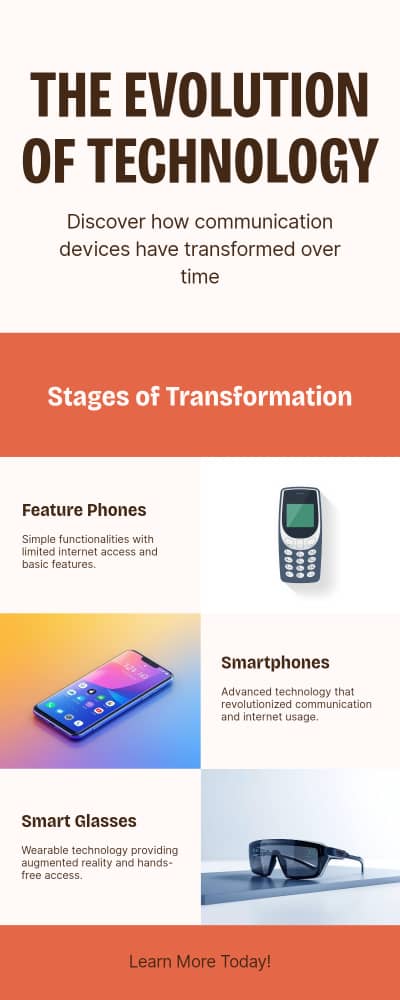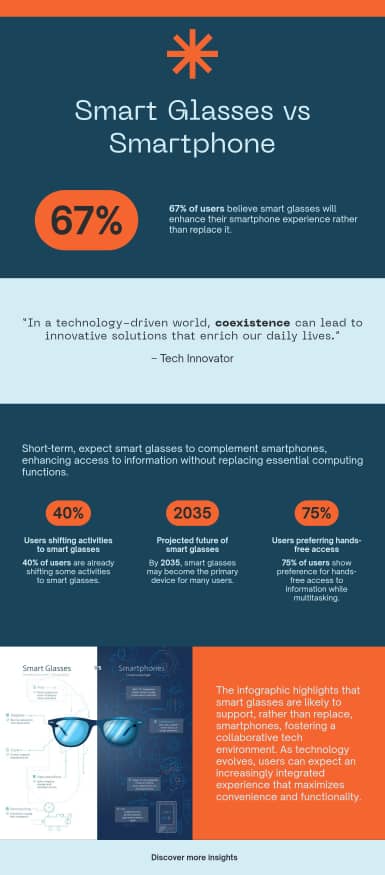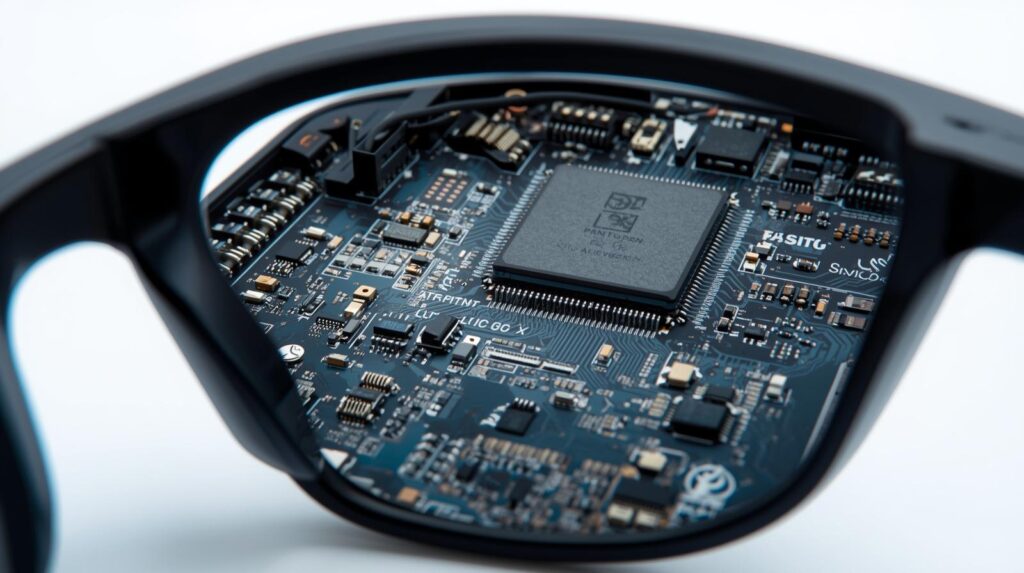Smartphones have been at the heart of our digital lives for more than a decade. They are our second brain, connecting us to the world, storing our memories, and allowing us instant communication. But there’s a new contender on the horizon: smart glasses. These were distant-future gimmicks once, but they are now being reshaped as sophisticated devices that could potentially replace smartphones in the future. Is such a future ever possible, though?
This piece explores the rise of smart glasses, their potential advantages, current limitations, and whether they will ultimately displace smartphones over the course of the next several years.
Why Smart Glasses Are Gaining Momentum
Technology firms such as Meta, Google, Apple, and Samsung are spending billions on developing smart glasses. The reason is clear: they think that wearable technology will be the next big consumer platform. Unlike early attempts such as Google Glass, today’s smart glasses are thinner, lighter, and supported by tremendous breakthroughs in AI (Artificial Intelligence) and AR (Augmented Reality).
The evolution is a replica of what happened to smartphones. Smartphones were expensive and clunky in their early years, and only geeks cared about them. Over time, form and price got better, and they became day-to-day necessities. The same trajectory may be the case with the rise of smart glasses, evolving from novelty items to day-to-day necessities.
The Path to Overtaking Smartphones

Gradual Evolution, and Not Day-Night Transformation
Just as feature phones did not disappear overnight with the advent of smartphones, smart glasses will not immediately replace smartphones. Their uptake will be a gentle curve, starting with technical enthusiasts, early adopters, and business users. Only after decades of advancement will they become full-fledged mainstream.
Hands-Free, Heads-Up Living
The greatest advantage of smart glasses is the heads-up and hands-free aspect. Instead of constantly going to grab a phone, people can see real-time information in front of them. Whether it is receiving turn-by-turn directions projected onto the road, or being alerted to an arriving text message while cooking dinner, smart glasses promise to bring more natural and seamless digital existence.
AI and AR Integration Driving the Shift
AI and AR are the real drivers of this revolution. Augmented reality imposes digital information on the real world, while AI personal assistants interpret it. Imagine your glasses recognizing products in a store, automatically translating signs in real time, or giving instantaneous medical information while exercising. This fusion does so much more than a smartphone can.
What Smart Glasses Could Do Better Than Smartphones
Whereas smartphones dominate in flexibility, smart glasses are capable of beating them in certain areas through offering a hands-free, immersive experience that redefines digital engagement. When it comes to travel and navigation, smart glasses can deliver real-time overlays of directions, landmarks, and transit details directly into the user’s field of vision without the need to constantly look at a phone screen.
They also support convenient communication, as their users can receive hands-free calls or view holographic text messages without interrupting whatever they were doing. Smart glasses, as immersive media, can display social media notifications or movies on holographic screens much wider and interactive than smartphone screens.
In the workplace, productivity will be benefited by features such as AR training, real-time collaboration, and enhanced fieldwork applications that drive efficiency and connectivity. In the same vein, the health and fitness industry can leverage smart glasses to track workout routines, display real-time performance data, and provide instant feedback in front of the wearer.
These innovations are the path that experts see technology heading toward an era when intelligent glasses could make smartphones obsolete as our primary digital companions.
Current Limitations Holding Them Back
Despite the hype, there are genuine issues preventing rise of smart glasses from ruling the roost yet.
Reliance on Smartphones
Most current smart glasses remain reliant on smartphones to access their processing capabilities and internet. They’re phone extensions rather than independent devices. Substitutes will only be available once glasses are stand-alone platforms.
Design and Comfort Challenges
Users expect technology that integrates seamlessly into day-to-day activities. Large frames, big batteries, or overheating are killers of adoption. Making fashionable, lightweight devices that users can wear easily all day long is an ongoing challenge.
Input and Interface Issues
Smartphones utilize responsive, fast touchscreens. Smart glasses will need other ways of input such as voice commands, gestures, or even brain-computer interfaces in the future. Until they are precise and natural, others may not adopt a full switch.
Smart Glasses vs Smartphones: Will They Coexist?

In the short run, coexistence is most likely. Smart glasses will complement the smartphone experience rather than replace it. Phones will remain the center for intensive computing and typing, while glasses supplement real-time overlays and hands-free access.
In the short term, while glasses are still not as independent, users will increasingly move more of their daily activities from their phones. And in the longer term, maybe by 2035 glasses can become so capable that they become the main device, and smartphones are relegated to secondary status.
The Future Outlook of Rise Of Smart Glasses
Industry experts predict adoption to start with enterprise and niche segments. Surgeons, for example, logistics staff, or engineers can be assisted by AR overlays in their line of work. With design advancements and prices plummeting, mass consumer market adoption will follow.For smart glasses to supplant smartphones, several breakthroughs must happen. For example, battery life needs to be lasting the entire day without overheating.
Some miniaturization tiny parts needed to be done without compromising design.Smart glasses also need to have sophisticated AI where it is context-aware, frictionless aid.The most important is Standalone connectivity. It is to make sure no dependency on smartphones.If those requirements are met, then smart glasses could potentially pass smartphones by, changing how we interact with technology for good.

Frequently Asked Questions (FAQ)
Q1: What are smart glasses?
Smart glasses are computing devices in the form of regular glasses with built-in displays, sensors, and connectivity that let the user see digital data with hands-free convenience.
Q2: Will smart glasses replace smartphones?
Not initially. They will most likely coexist for years, with the glasses performing real-time, hands-free functions and the smartphone still required for detailed work.
Q3: What are the advantages of smart glasses compared to smartphones?
Smart glasses offer hands-free instructions, interactive AR experiences, natural communication, and enhanced productivity, thus being more convenient in some situations.
Q4: What are the challenges for smart glasses?
Current drawbacks are smartphone dependence, shape and ergonomics, power consumption, and enhanced input models like voice or gesture input.
Q5: When would smart glasses be able to replace smartphones?
Experts say it may take a decade or more for the rise of smart glasses to be sophisticated, affordable, and fashionable enough to supplant smartphones as the main devices.
Final Thoughts On The Rise Of Smart Glasses
Smart glasses are the most promising step towards the day when our physical and digital worlds become perfectly merged. The transition won’t be occurring overnight, however. Smartphones are still too important to untangle complex tasks, text input, and content creation.
The likeliest future is an evolution toward coexistence of glasses with more tasks assumed by them until they eventually may supplant smartphones. Whether or not that occurs in 10, 15, or 20 years will depend on how quickly the market can surmount design and usability challenges.
One thing is for sure. the rise of smart glasses represent a new era of human-technology interaction, one that is more natural, immersed, and connected.
Discover more from CollaMedia 酷乐新媒体
Subscribe to get the latest posts sent to your email.











